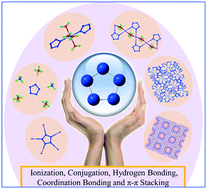Origin of the considerably high thermal stability of cyclo-N5− containing salts at ambient conditions
Abstract
Nineteen cyclo-N5− containing salts with considerably high thermal stability at ambient conditions were experimentally reported in the past two years. This work focuses upon the origin of the rather high thermal stability of these salts, in combination with the analysis of the crystal packing. In the lattice, cyclo-N5− exists in various manners, i.e., as an independent ring without covalent bonding, as a moiety of zero-, one- or three-dimensional stacking structures, or even as complex zeolite-like architectures. The high structural diversity of cyclo-N5− containing salts originates from the η-σ coordination bonding between cyclo-N5− and various metal atoms, with or without hydrogen bonding. Meanwhile, we conclude that the considerably high thermal stability of the salts is attributed to the ionization and conjugation of cyclo-N5−, and the hydrogen bonding, coordination bonding and π–π stacking between cyclo-N5− and surrounding molecules and/or atoms in the lattice. Among these factors, the ionization is the first premise for stability. Moreover, keeping the high planarity of cyclo-N5− is crucial to maintaining the high thermal stability of the cyclo-N5− salts. Thus, more and more cyclo-N5− salts with high stability are expected to come into being soon, setting a substantial basis for pentazole chemistry research. This insight facilitates guiding the manufacture of new cyclo-N5− containing salts and developing a strategy for stabilizing other unstable chemical species under common conditions.



 Please wait while we load your content...
Please wait while we load your content...